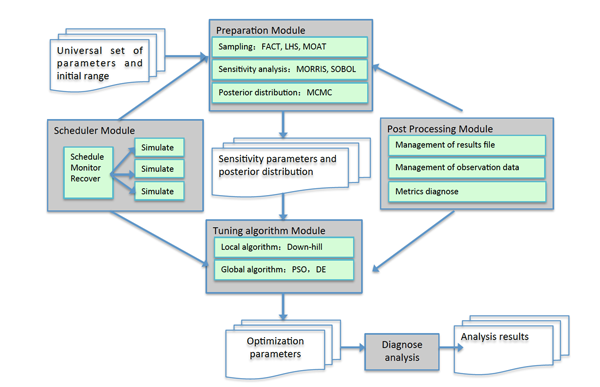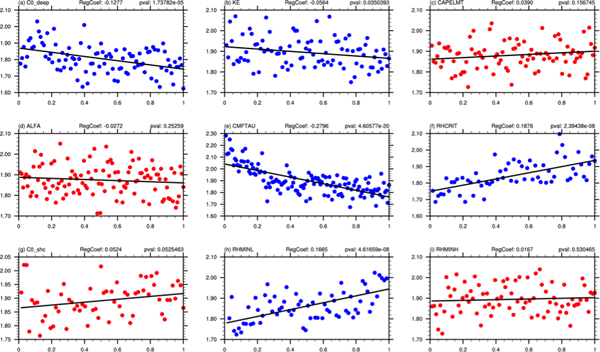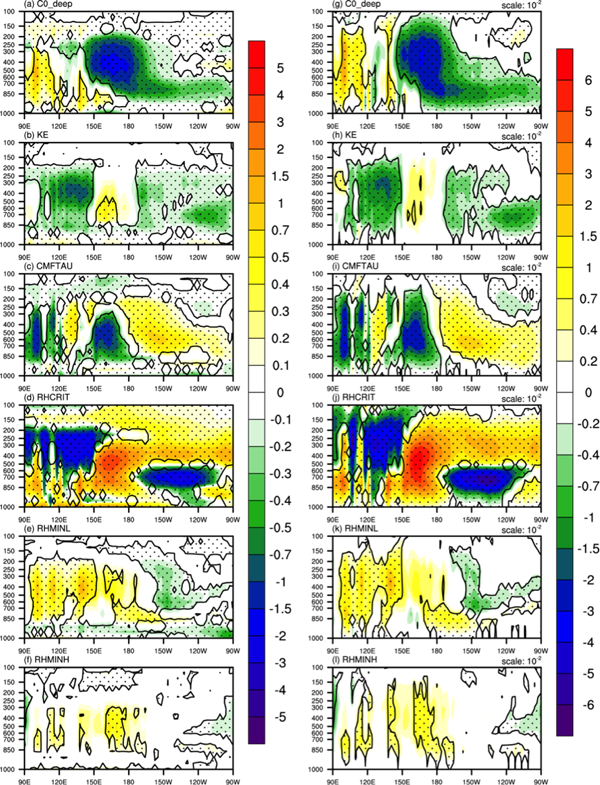State Key Laboratory of Numerical Modeling for Atmospheric Sciences and
Geophysical Fluid Dynamics (LASG)
Institute of Atmospheric Physics, Chinese Academy of Sciences

Vol. 4/No.4 December 2017
[Model development, algorithm, and evaluation] Quantification of the responses of equatorial Pacific surface wind to uncertain cloud-related parameters in GAMIL2
In GCMs, uncertain parameters in model physical schemes introduce large uncertainties into climate simulations and projections. Uncertainty quantification and parameter tuning are generally applied to reduce model biases. Previous studies are mainly focused on model variables or physical processes including precipitation, cloud amount, and radiation, which are directly controlled by or closely associated with uncertain parameters. However, as a dynamic quantity that is not directly influenced by uncertain parameters, is there the potential to improve simulated surface wind by parameter tuning?
Dr. Xie Feng, Prof. Li Lijuan, Prof. Wei Xue (Tsinghua University) and Prof. Wang Bin have explored the potential for improving simulated surface winds by parameter tuning using GAMIL2. First, they built an automatic and effective parameter optimization system based on GAMIL2 (Fig.1). Using the optimization system, they found that the surface winds are highly sensitive to, and even linearly dependent on some parameters, indicating the potential to improve surface wind simulations by tuning these parameters (Fig. 2). Parameter changes indirectly affect surface winds (or Pacfic Walker Circulation) through changes in vertical velocity or deduced circulation linked to diabatic heating (DH) above the surface (Fig. 3).

Figure 1. The structure of the automatic calibration workflow. The input of the workflow is the parameter set interest and their initial value ranges. The output is the optimal parameters and their corresponding diagnostic results after calibration. The preparation module provides the parameter sensitivity analysis. The tuning algorithm module offers local and global optimization algorithms including the downhill simplex, genetic algorithm, particle swarm optimization, differential evolution, and simulated annealing. The scheduler module schedules as many as cases to run simultaneously and coordinates different tasks over a parallel system. The post-processing module is responsible for metrics diagnostics, re-analysis and observational data management.

Figure 2. Responses of surface zonal wind RMSEs (units: ms−1) based on ERA-interim (2003) to different parameters (normalized to [0,1]) over the tropical Pacific (10S–10N, 90E–90W). Each point represents the RMSE for each perturbed parameter experiment. Blue points represent linear trends that are statistically significant at the 95% confidence level, while red points represent those that are not statistically significant at the 95% confidence level. Black lines denote linear regression lines between RMSEs and parameters.

Figure 3. Vertical cross-sections of the responses of (a)–(f) diabatic heating (units: K/day) and (g)–(l) vertical velocity (units:10−2 Pa s−1) to different parameters over the equatorial (5S–5N) Pacific.
Citation
Feng Xie, Wei Xue, Lijuan Li*, Tao Zhang, Bin Wang, and Shiming Xu, 2017: Quantification of the responses of equatorial Pacific surface wind to uncertain cloud-related parameters in GAMIL2, Atmos. Sci. Let., doi: 10.1002/asl.789
Feng Xie, Lijuan Li*, Bin Wang and Wei Xue, 2017: Impacts of uncertain cloud-related parameters on Pacific Walker circulation simulation in GAMIL2, Atmos. Oceanic Sci. Lett,
doi: 10.1080/16742834.2018.1392228
Tao Zhang, Lijuan Li*, Yanluan Lin, Wei Xue*, Feng Xie et al., 2015: An automatic and effective parameter optimization method for model tuning, Geosci. Model Dev., 8, 3579–3591
E-mail: lasg_newsletter@lasg.iap.ac.cn
Editors: Chuanyi Wang (wangcy@lasg.iap.ac.cn), Kangjun Chen(ckj@lasg.iap.ac.cn)